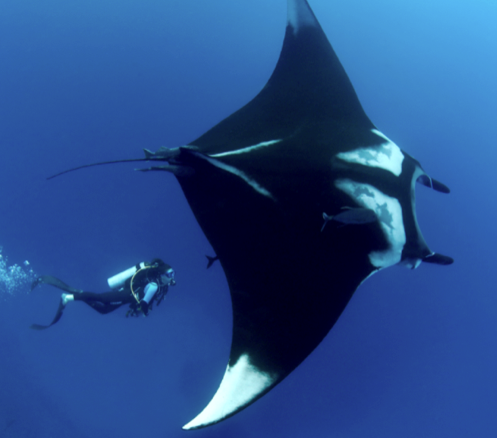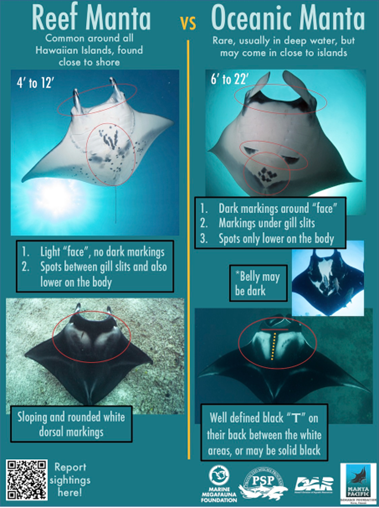11/2/23 – Protected Species Spotlight: Manta Rays
By: Devon Stapleton
DAR Protected Species Program
Meet the Species
Have you ever seen an oceanic manta ray? The oceanic manta ray, or Mobula birostris, is the largest ray species in the world. According to NOAA, this gentle giant has a wingspan reaching up to 26 ft and weighing over 5,300 pounds! Oceanic mantas are known to live over 45 years, based off of photo-identification records. Manta rays give birth to a single live pup, and when they are born they must immediately fend and forage for themselves.

Photo by Dr. Andrea Marshall, Marine Megafauna Foundation
Behaviors
Oceanic mantas are usually found further offshore compared to reef mantas. Both species are often solitary, but will aggregate for feeding, cleaning stations, and males around a female for mating. Mantas have the largest brains to body mass ratio compared to other fish, making them extremely intelligent. It has been found that they are very social creatures.
Mantas are filter feeders that eat zooplankton. They feed by unfurling their cephalic fins, the fins on the sides of their mouth, to help funnel water and prey through their wide open mouth and over their gill rakers. The gill rakers filter out specific plankton that get diverted to their stomach, while the rest of the water pushes out their gills. Mantas use many different types of feeding strategies, such as working together to make feeding chains and even barrel rolling.

Photo by Keller Laros, Manta Pacific Foundation
Identification
Oceanic mantas (Mobula birostris) and reef mantas (Mobula alfredi) are often confused for one another, and until recently, were thought to be one species. In 2009, Dr. Marshall and her team documented the visually distinct differences between oceanic mantas and reef mantas. In 2011, Dr. Kashiwagi and others analyzed and confirmed the genetic difference between the species.
Oceanic manta rays: The dorsal surface (topside) of the oceanic manta ray is dark with two white triangular markings and marked without a gradient. The line of separation between these two white areas forms a “T.” Their ventral (underside) has a white coloration with black spots clustered below their gills (but not between the gills). The edges of their bodies tend to have dark margins including their cephalic fins and around their mouth. See image below.
Reef manta rays: The reef manta ray has a dark dorsal surface (topside) also with two lighter areas on top of the head, forming a gradient of its dark back coloration to white or gray, making a sort of “Y” in the darker back area between the patches. The reef manta ray also has a white belly, often with dark spots primarily between and below the gills but also along the margins of the belly. See image below.

Main Threats
The oceanic manta ray was listed as threatened under the endangered species act in 2018.
Due to their large bodies, oceanic manta rays are highly susceptible to entanglement in commercial and recreational fisheries. The entanglements can cause damage to the manta rays’ cephalic fins, or pectoral fins, resulting in amputations, making it harder for them to swim and feed, or even result in death.
In many parts of the world, manta rays are illegally hunted for their gill rakers, fueled by a high demand in East Asia for their use as “healing tinctures” that are not proven effective. Mantas can also be injured from boat strikes when feeding or traveling just below the surface, become entangled in nets or other types of fishing gear, and the impacts of microplastic ingestion is an increasing concern. Ocean acidification from climate change may also have a significant impact on zooplankton, their primary food source.
There is still so much we need to learn about the oceanic manta rays. The largest aggregation of oceanic manta rays was recently discovered off the coast of Ecuador – more than 10 times larger than any other known subpopulation! DAR is working with Manta Pacific Foundation and Marine Megafauna Foundation to hopefully find oceanic manta aggregation sites in Hawaiian waters so that we can get a better understanding of their population size and how to better protect them.
What You Can Do to Help
Help us identify and track mantas by reporting any sightings! If able, please take photos of the underside of the manta, showing their spot pattern.
Report oceanic manta ray and Big Island reef manta sightings here:
http://www.mprf.net/identification/report-a-sighting.html
Report any other reef manta sightings (Oahu, Kauai, Maui, etc.) here:
https://www.hamerinhawaii.org/manta-ray-sighting-form
When boating, have someone on look out for any marine species (like manta rays, our sometimes sluggish sea turtles and of course whales) to help avoid boat strikes, the props of boats can cause fatal injuries. Drive slowly, 5 to 10 knots, near harbors and maintain “no wake” speeds within 200 feet of shoreline. Wearing polarized sunglasses can help you see marine life in the water.
When going fishing, please be aware of high manta use areas: areas where there is a lot of upwelling – usually a steep drop off. Consider moving locations or bringing in lines if you see a manta in the area to help avoid entanglements. Using barbless, non-stainless steel hooks and appropriate test nylon monofilament or fluorocarbon line can help reduce the harm to an animal if it does become entangled.
References and further reading:
Kashiwagi T, Marshall AD, Bennett MB, Ovenden JR. (2012, July). The genetic signature of recent speciation in manta rays (Manta alfredi and M. birostris). Mol Phylogenet Evol. https://pubmed.ncbi.nlm.nih.gov/22503670/
Marshall A, Bennett MB, Kodja G, Hinojosa-Alvarez S, Galvan-Magana F, Harding M, Stevens G, Kashiwagi T. (2011) Manta birostris. The IUCN Red List of Threatened Species. www.iucnredlist.org
Marshall, A.D., Compagno, L.J.V. and Bennett, M.B. (2009). Redescription of the genus Manta with resurrection of Manta alfredi (Krefft, 1868) (Chondrichthyes; Myliobatoidei; Mobulidae). Zootaxa. https://www.researchgate.net/publication/43517309_Redescription_Of_The_Genus_Manta_With_Resurrection_Of_Manta_Alfredi_Krefft_1868_Chondrichthyes_Myliobatoidei_Mobulidae
Miller, M.H. and C. Klimovich. (2017, September 01). Endangered Species Act Status Review Report: Giant Manta Ray (Manta birostris) and Reef Manta Ray (Manta alfredi). Report to National Marine Fisheries Service, Office of Protected Resources, Silver Spring, MD. https://www.fisheries.noaa.gov/resource/document/endangered-species-act-status-review-report-giant-manta-ray-manta-birostris-reef
NOAA Fisheries (2023, September 11). Giant Manta Ray. https://www.fisheries.noaa.gov/species/giant-manta-ray
Whitney JL, Coleman RR, Deakos MH. (2023). Genomic evidence indicates small island-resident populations and sex-biased behaviors of Hawaiian reef Manta Rays. BMC Ecol Evo 23, 31. https://doi.org/10.1186/s12862-023-02130-0.
William T White, Shannon Corrigan, Lei Yang, Aaron C Henderson, Adam L Bazinet, David L Swofford, Gavin J P Naylor. (2018, January 1). Phylogeny of the manta and devilrays (Chondrichthyes: mobulidae), with an updated taxonomic arrangement for the family. Zoological Journal of the Linnean Society. https://doi.org/10.1093/zoolinnean/zlx018
